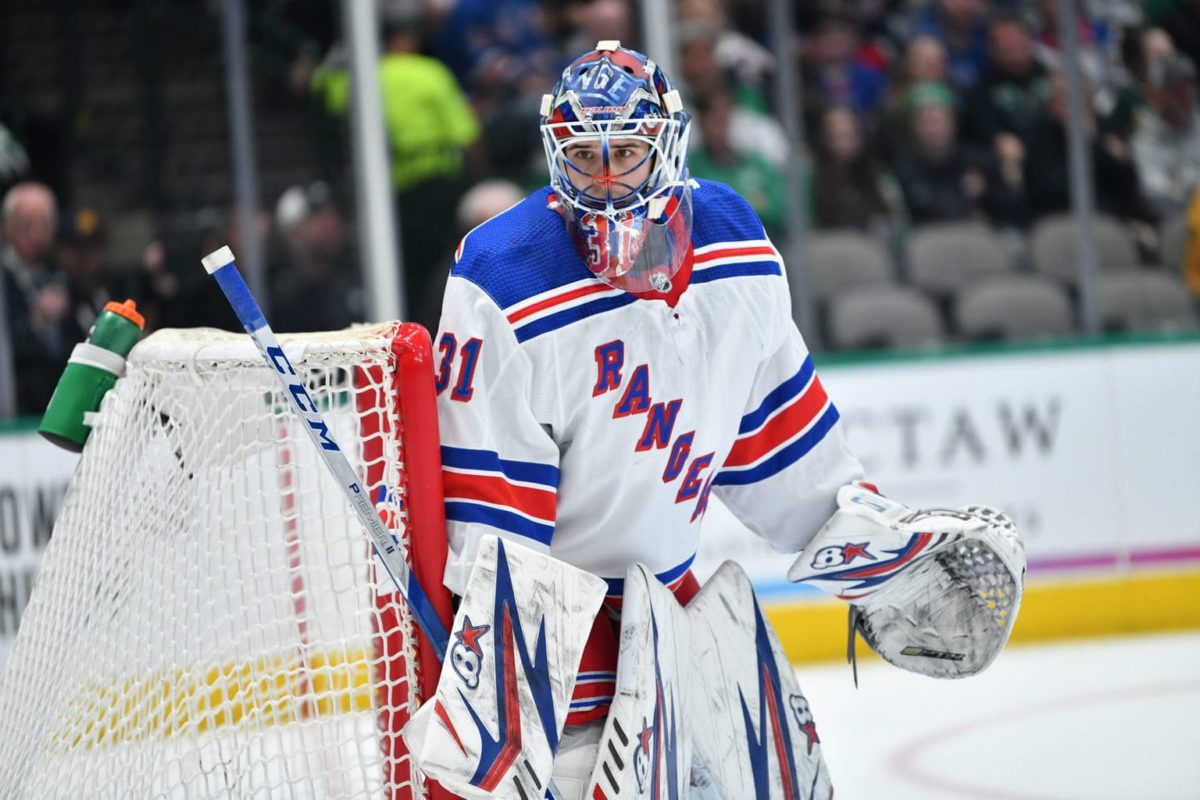Following the New York Rangers’ 3-2 overtime loss to the Boston Bruins on Wednesday night, the goaltending shuffle persists. Despite the disappointing result, the Rangers forced one of the best teams in the league into extra minutes, which displayed their budding tenacity, a quality head coach David Quinn has been pushing for since the Rangers hired him. During another work-in-progress season on Broadway, that’s something to celebrate.

Quinn decided to start 25-year-old Alexandar Georgiev in net, who had not played in 12 days. Despite Igor Shesterkin’s successful streak, the coaching staff made the tough call to give Georgiev the green light. The argument was that he had been successful against the Bruins in previous seasons and cannot develop if he stays on the sidelines. Though Shesterkin was not the reason for the Rangers’ loss in the previous game, his fate was sealed.
Georgiev’s Recent Performance
Georgiev faced 32 shots from the Bruins and allowed three total goals, which resulted in a .906% save percentage (SV%) for the night. His overarching challenge were breakaways. In fact, two of the Bruins’ three goals were off a breakaway, one in regulation and one shorthanded. While the Rangers’ defense is working on chemistry, their goaltending duo will face their share of breakaways. With that said, these goals are opportunities that need to be snuffed. Will allowing the goaltending pair to get into a rhythm assist in better saves?
A defensive blunder at the hands of Jacob Trouba led to the second tying goal, stressing the theme of goaltending overcompensation during the team’s rebuilding phase. No one expected the Rangers to have it together this season, and that’s not going to be the case for the next several seasons. However, there were some reassuring takeaways from their swift overtime loss. Just as other areas had positives, like bottom-six contributions and defensive bright spots in Adam Fox and K’Andre Miller, Georgiev deserves praise.
He looked solid in net. Not as sound as Tuukka Rask across the ice, but Georgiev made some crucial saves off a relentless Bruins offense. He got some help from his crossbar, which just reinforces how fearless the Bruins are at shooting the puck and how other teams will take advantage of a shaky goaltending department.
The Rangers find themselves on the penalty kill often. Yet the team is also quite inconsistent killing the penalty, despite how often they are in this situation. On the penalty kill, there is extra responsibility placed on the goaltender. We’ve seen from Georgiev recently that he was able to shut down the Bruins on their power play, which is not an easy feat. The Rangers sent the Bruins on the power play several times, but he helped keep his team in the game.
Georgiev often starts strong and steady. That’s not always the case with Shesterkin, but the two tend to finish their games strong. The Rangers lit the lamp first in the opening frame, and the Bruins did not get on the board until the halfway point of the game. Just after the first two periods, the Bruins threw an assertive 25 shots on Georgiev.
Shesterkin’s Recent Performance
Shesterkin met the New York Islanders, Washington Capitals, and the Pittsburgh Penguins and walked away with a 2-1-0 record before Quinn handed the reigns to Georgiev again. Quinn’s original plan was to alternate goaltenders every other game. It is apparent there are many moving parts this season that are working against each other for the Rangers. And the goaltending situation seems to be one of them.
Following his involvement in a recent confrontation with defenseman Tony DeAngelo, Quinn explained that the staff gave Georgiev time to “unwind a little bit and get back into the groove of things.” Though this was one factor that kept Shesterkin in net, the 25-year-old Russian built a strong case to stay in the crease (From ‘Rangers want Alex Georgiev to ‘unwind’ after heated Tony DeAngelo altercation’, New York Post, 2/3/2021).
In the short stretch of three games that Shesterkin saw, he faced 89 shots for a .944 SV% against some offensively aggressive teams — impressive considering he faced an average of roughly 30 shots per game. Though Shesterkin’s most recent game was a loss to the Islanders, the blame doesn’t fall on him.
The halted rotation was serving him well until Quinn made the controversial decision to break the pattern. However, the club should experiment with a starting stretch that’s longer than this. Shesterkin can, at times, look shaky in the beginning but tends to work through it during the course of a game. The constant hot and cold rotation seems to prevent him from getting in the habit of looking more steady in the opening period.
Given Shesterkin’s NHL debut last season, the stark contrast between consistent starts last season and this season’s constant rotation is most likely playing a role in his performance. In 2019-20, he was dubbed the starter to finish the regular season. Before long, he was making jaw-dropping saves game after game while being riddled with shots. Before the hiatus, he posted a 10-2 record with a .932 SV% in that span.
Tonight’s Meeting With the Boston Bruins
The Rangers meet the Bruins again at Madison Square Garden without their top offensive threat, Artemi Panarin. Shesterkin is confirmed to start; meanwhile, the Rangers will face Jaroslav Halak for the Bruins. The decision to switch the netminder once more halts the opportunity for one of the goalies to get into a groove.
It’s clear the Rangers’ defense is still working through weak areas, and in the meantime, the club will need to lean harder on the goaltender. Yet with both goaltenders struggling to find their stride themselves, this seems to perpetuate into a vicious cycle. From what Shesterkin had shown last season, he can be a franchise goaltender. Perhaps it is time to switch the plan from rotating to testing the goaltenders and then riding the hot hand.